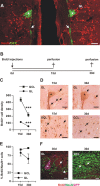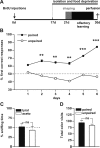Olfactory discrimination learning increases the survival of adult-born neurons in the olfactory bulb
- PMID: 17035535
- PMCID: PMC6674694
- DOI: 10.1523/JNEUROSCI.2633-06.2006
Olfactory discrimination learning increases the survival of adult-born neurons in the olfactory bulb
Abstract
In the olfactory bulb (OB), new neurons are added throughout life, forming an integral part of the functioning circuit. Yet only some of them survive more than a month. To determine whether this turnover depends on olfactory learning, we examined the survival of adult newborn cells labeled with the cell division marker BrdU, administered before learning in an olfactory discrimination task. We report that discrimination learning increases the number of newborn neurons in the adult OB by prolonging their survival. Simple exposure to the pair of olfactory cues did not alter neurogenesis, indicating that the mere activation of sensory inputs during the learning task was insufficient to alter neurogenesis. The increase in cell survival after learning was not uniformly distributed throughout angular sectors of coronal sections of the OB. Monitoring odor activation maps using patterns of Zif268 immediate early gene expression revealed that survival was greater in regions more activated by the non-reinforced odorant. We conclude that sensory activation in a learning context not only controls the total number of newborn neurons in the adult OB, but also refines their precise location. Shaping the distribution of newborn neurons by influencing their survival could optimize the olfactory information processing required for odor discrimination.
Figures



References
-
- Abrous DN, Koehl M, Le Moal M. Adult neurogenesis: from precursors to network and physiology. Physiol Rev. 2005;85:523–569. - PubMed
-
- Bauer S, Moyse E, Jourdan F, Colpaert F, Martel JC, Marien M. Effects of the alpha 2-adrenoreceptor antagonist dexefaroxan on neurogenesis in the olfactory bulb of the adult rat in vivo: selective protection against neuronal death. Neuroscience. 2003;117:281–291. - PubMed
-
- Belluscio L, Lodovichi C, Feinstein P, Mombaerts P, Katz LC. Odorant receptors instruct functional circuitry in the mouse olfactory bulb. Nature. 2002;419:296–300. - PubMed
Publication types
MeSH terms
LinkOut - more resources
Full Text Sources
Miscellaneous
